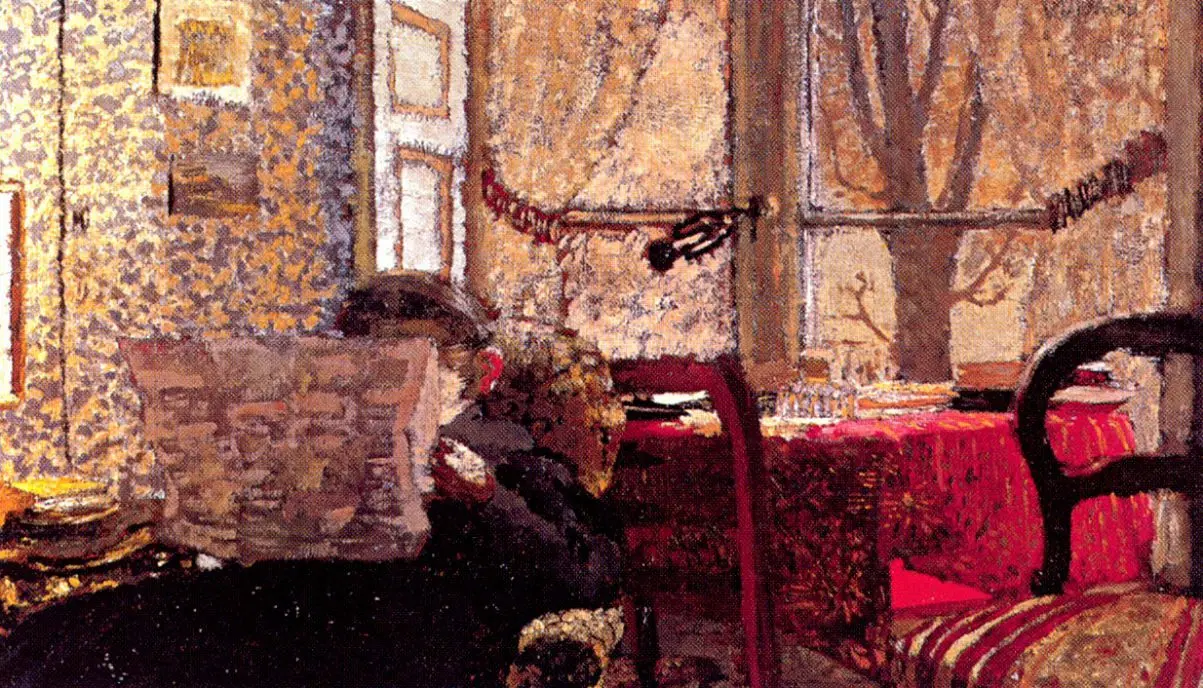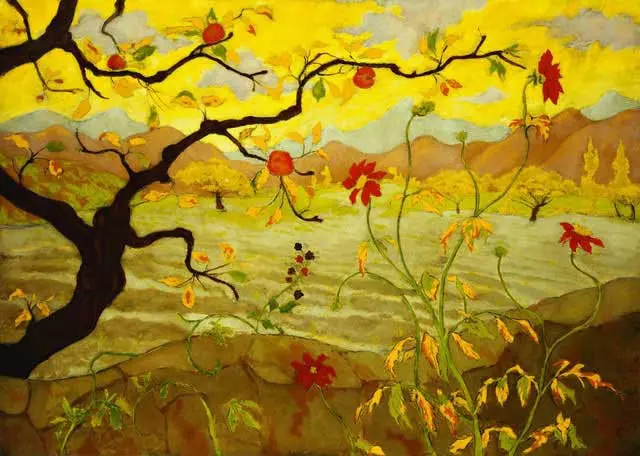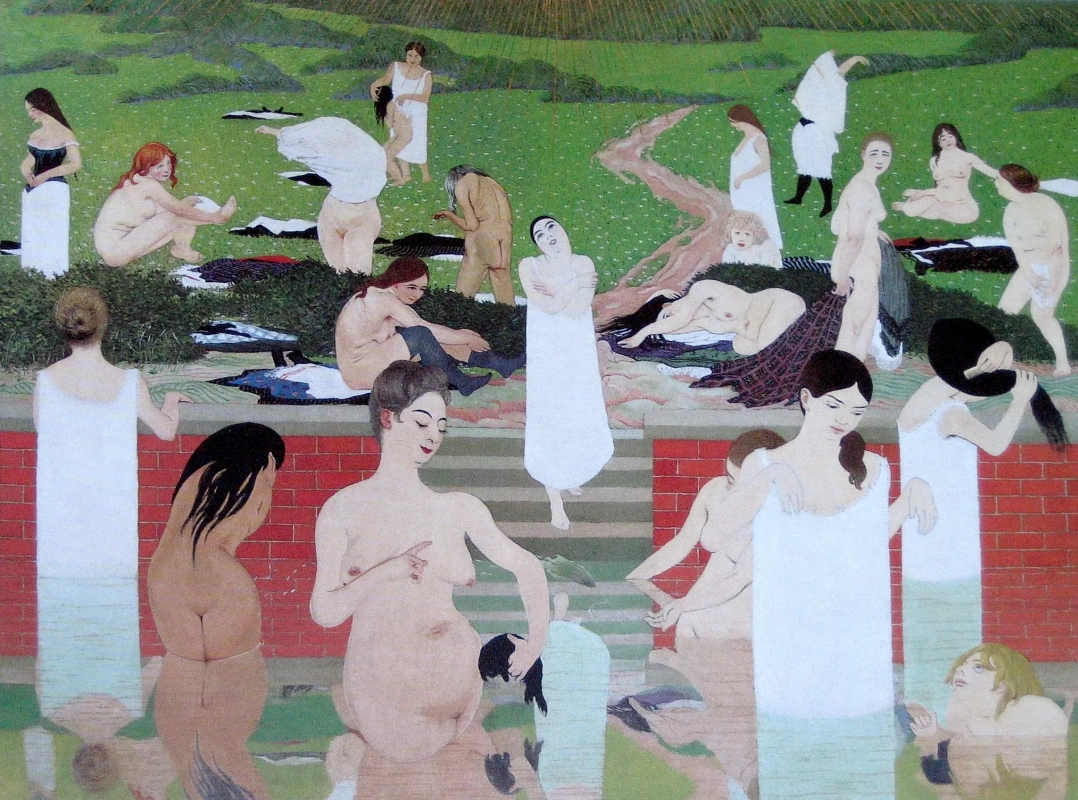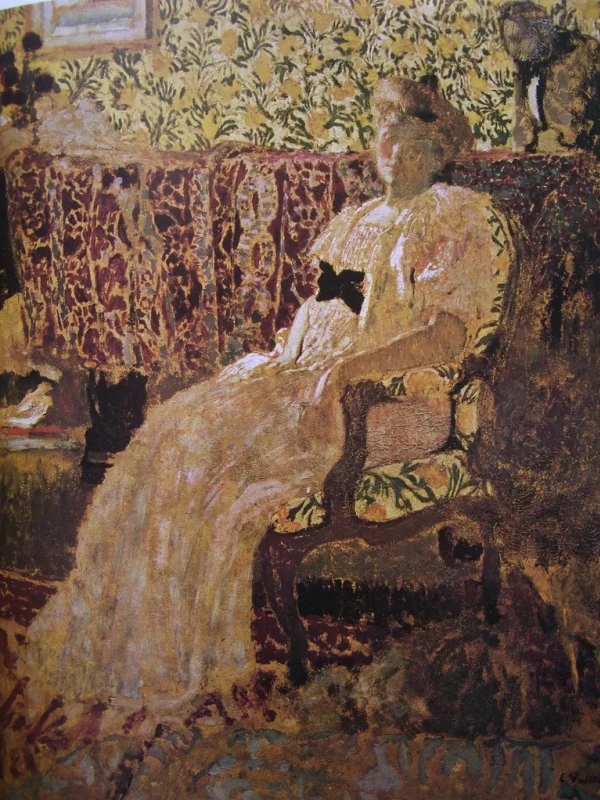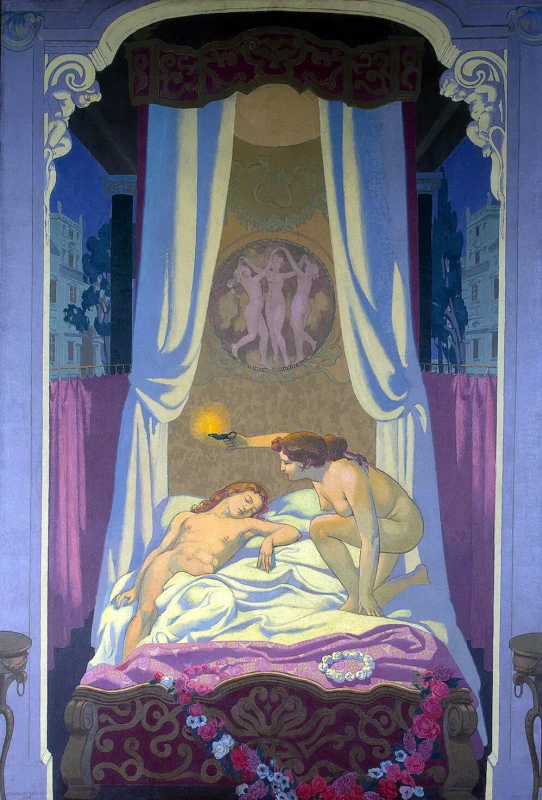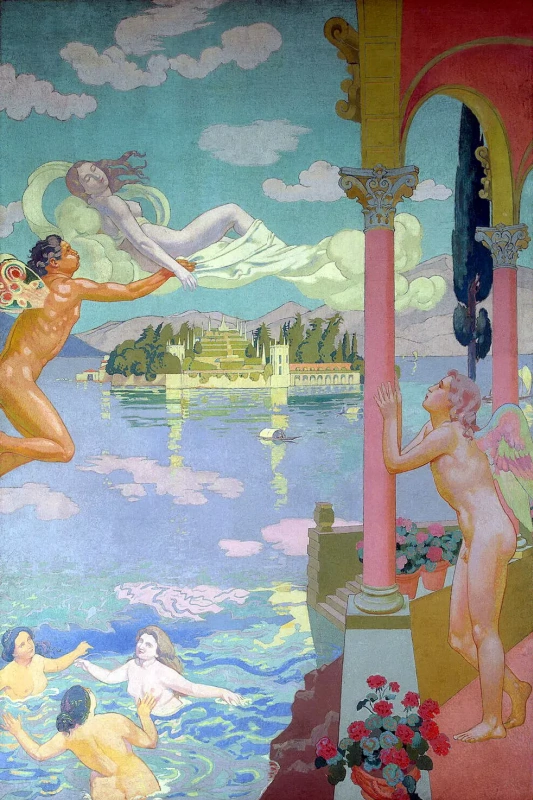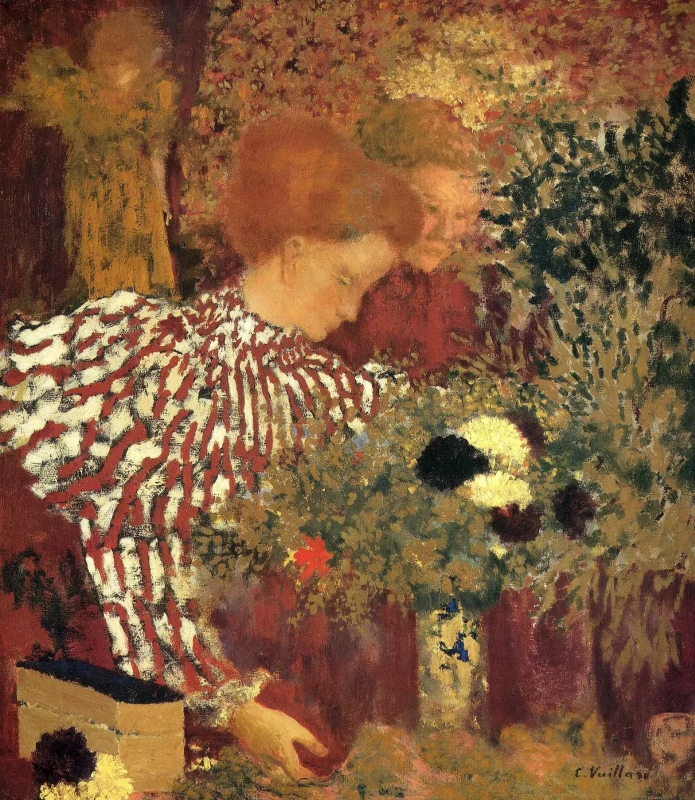The Nabis (Les Nabis), a group of French painters, are difficult to classify as fully belonging to a major artistic trend like Impressionism
, Expressionism
, or Art Nouveau. Though contemporaries of all these powerful movements, the Nabi artists directed their art along a narrow and winding course somewhere in between.
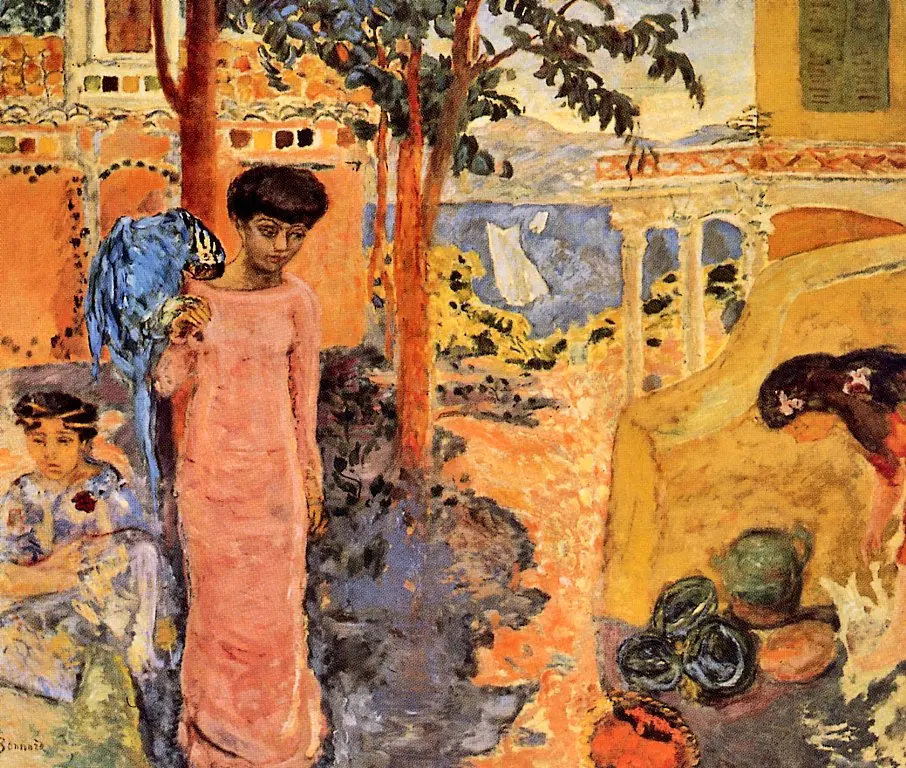
Nabi is the Hebrew for prophet. It was Auguste Cazalis, a poet and scholar of ancient Oriental languages, who suggested the name to the group of young artists when they were first discussing their collective artistic goal in 1888. The founders of the group, Paul Sérusier, Pierre Bonnard, Jean-Édouard Vuillard, and Maurice Denis, believed they were making a revolution in art, but were quite ironic about being called prophets. ‘The Nabi of Beautiful Icons' was Maurice Denis’s nickname, ‘the Nipponised Nabi' Bonnard’s, ‘the More Nipponised than the Nipponised Nabi' Ranson’s, ‘the Intimist Nabi' Vuillard’s, and Sérusier was called ‘the Nabi with the Sparkling Beard.' A painter’s role they treated in a rather mystical way — as that of a priest, a medium who reveals the invisible.
Five artists
1903, 145×187 cm
The box of cigars
In the late 19th century, the private art school known as the Académie Julian, where Paul Sérusier, Maurice Denis, Jean-Édouard Vuillard, Paul Ranson, and Pierre Bonnard first met and studied, was the most significant rival to the Academy of Fine Arts in Paris. The rivalry had nothing to do with ideology, though, for the teachers were the very same academicians who selected paintings for the Salon. Paris had already seen all the eight Impressionist exhibitions, Gauguin was about to leave for Polynesia, Van Gogh had painted in Arles almost all of his Sunflowers — but in the Académie Julian, they kept painting cupids, myths, and historical scenes. The future Les Nabis were then about twenty years old, they were diligent in doing their academic course and knew next to nothing about the Impressionists. Then, one day, Paul Sérusier met Paul Gauguin.In 1888, in the town of Pont-Aven, Brittany, Gauguin and Sérusier spent time together painting, discussing art, smoking cigars, and covering canvases not with the colour mix from the palette, but with pure paints straight out of the tubes. Here, Gauguin gave his young colleague some good lessons, ‘How do you see these trees? They are yellow. Well, then, put down yellow. And that shadow is rather blue. So render it with pure ultramarine. Those red leaves? Use vermilion.' Following the recommendations, Sérusier painted a rough study
on the cardboard lid of a cigar box. On returning to Paris, he named it The Talisman and used it as an illustration to explain to his friends from the Académie Julian Gauguin’s principles of Synthetism and subjective view of nature. Later, Maurice Denis remembered, that it was the moment when he and his friends felt ‘liberated from all the yokes that the idea of copying brought to [their] painters' instincts.'
Les Nabis would gather in a studio, mainly at Ranson’s. Besides learning from Gauguin, they had long talks on Plotinus’s philosophy, read Mallarmé and ancient Semitic literature, immersed themselves in neo-Catholic mysticism, took interest in Puvis de Chavannes's Symbolist paintings brewed on decorativeness, allegories, and the ideals of the Renaissance
.
Katherine M. Kuenzli, a UK art historian, who wrote a book about the Nabis, says that they took upon themselves to reshape a painter’s relationship with the artistic tradition, subjective perception, and objective reality, all together! She states they focused on a number of important tasks, ‘… first, a renegotiation of the relationship between sensation and imagination in an attempt to make modern art more enduring; second, an attempt to move beyond easel painting and to conceive of art as an environment; third, a dream of connecting the individual to some form of collective ideal or experience; and fourth, an attempt to synthesize modernity with tradition.'
Katherine M. Kuenzli, a UK art historian, who wrote a book about the Nabis, says that they took upon themselves to reshape a painter’s relationship with the artistic tradition, subjective perception, and objective reality, all together! She states they focused on a number of important tasks, ‘… first, a renegotiation of the relationship between sensation and imagination in an attempt to make modern art more enduring; second, an attempt to move beyond easel painting and to conceive of art as an environment; third, a dream of connecting the individual to some form of collective ideal or experience; and fourth, an attempt to synthesize modernity with tradition.'
Morning in Paris
1911, 76×122 cm
Right place, right time
The Nabis' first exhibitions, quite small ones, took place at Paul Ranson’s studio. Besides painters, they were visited by poets, owners of periodicals and theatres. Yet, each painter was free to develop his individual style. Though belonging to the group, the artists were not constrained by the principles and concepts of their group exhibitions. At that time, Félix Valloton, Ker-Xavier Roussel, and Aristide Maillol joined them.In the previous twenty years, Parisian art dealers and publishers of forward art magazines had been trained by the Impressionists and Post-Impressionists to be sharp-sighted for notable novel trends. So, they welcomed Les Nabis immediately. Ambroise Vollard bought their paintings for his collection and displayed them in the gallery in rue Lafitte. Their pictures were admired by, and aroused a professional interest in the Franco-German art dealer Samuel Siegfried Bing, who put them up for sale in his shop Maison de l’Art Nouveau (‘House of New Art'). A couple of decades earlier, that very Bing had been one of the first to start selling in Paris Japanese prints, netsukes, screens, and kimonos. In return, he showed new French art in Japan. Now, the Nabi painters were his new passion — later he would be as passionate about Art Nouveau.
However, the Nabis' principal patrons were the Natanson brothers who ran the Avant-garde magazine La Revue blanche. That periodical was the first to publish an enthusiastic review of Cézanne, and it had Marcel Proust, Paul Verlaine, Claude Debussy, and Guillaume Apollinaire among its contributors.
Thadée Natanson’s wife Misia, who patronised young artists and was Vuillard’s and Bonnard’s favourite model.
Every issue of La Revue blanche contained lithographs by the Nabis, and Maurice Denis wrote several articles that, collectively, formed a coherent theoretical basis for the Nabis' artistic explorations. Later, a saying by Denis has often been quoted by modern art historians for its vividness, ‘Remember that a painting — before it is a battle horse, a nude model, or some anecdote — is essentially a flat surface covered with colours assembled in a certain order.' Today, it may hardly seem a revelation — rather a position typical of almost all Avant-garde
isms. But Wassily Kandinsky would only be making statements like that about twenty years later, and about twenty five years were to pass before Kazimir Malevich started thinking in a similar way.
This is how the Nabi historian Charles Chasse explains what the members of the group aspired to, ‘A picture had meaning only when it possessed "style." That is to say when the artist had succeeded in changing the shape of the objects he was looking at and imposing on them contours or a colour that expressed his own personality.'
Each of the painters, intent on finding the fundamentals — spiritual, mystical, philosophic, ethical, and mundane — of his personality, developed his individual style, different from those of his colleagues. The Nabis, indeed, are utterly unlike.
This is how the Nabi historian Charles Chasse explains what the members of the group aspired to, ‘A picture had meaning only when it possessed "style." That is to say when the artist had succeeded in changing the shape of the objects he was looking at and imposing on them contours or a colour that expressed his own personality.'
Each of the painters, intent on finding the fundamentals — spiritual, mystical, philosophic, ethical, and mundane — of his personality, developed his individual style, different from those of his colleagues. The Nabis, indeed, are utterly unlike.
Square Vintimille. Patanella screen for margaritas Shape
1911, 230×300 cm
On the verge of Art-Nouveau
To speak in earnest about the Nabis as designers who worked for theatres, decorated people’s homes and drew advertisements, we have to remember the original noble spirit, both aesthetic and intellectual, of the term ‘decorative.' It was the field where Bonnard, Vuillard, Denis were developing and honing to perfection the language of what was to become Art Nouveau. They painted series of panels for private houses and public buildings, designed patterns for wallpaper and home textiles, decorated dinner-services and stained-glass windows, created scenery for theatrical productions after Ibsen and Maeterlinck. Unlike Pissarro and Renoir, who not so long before had had to paint curtains and tavern walls out of eternal want of money, the Nabis felt at home in the world of commercial commissions and aesthetic challenges. Some critics find that their work was close to the Renaissance tradition of decorating churches and homes with murals. The functions of art remain the same, no matter where — in a museum, a Christian centre, or a parlour.In 1907, Russian art collector Ivan Morozov's Moscow mansion in Prechistenka Street was completed. It was designed specifically to house his huge collection. He commissioned Bonnard to paint the panel On the Mediterranean, and invited Denis to decorate the concert room. Denis exhibited the series of panels The Story of Psyche at the Salon d’Automne, and in 1909, sent them to Moscow. Soon, he himself arrived in Russia, to supervise the installation of the panels. In a free minute, he sketched out a design for Morozov’s furniture and patterns for its upholstery. Denis commissioned from Aristide Maillol the statues for the concert room, and with the pottery designer André Metthey he created a set of vases.
As the precursors of the mainstream ideas of Art Nouveau, the Nabis blurred the boundaries between art and a billboard, between public and private. They enriched their paintings by using techniques characteristic of the style of printed advertisements, Japanese prints, playbills. Plain shapes, decorativeness, large, evenly coloured, areas with no attempt to imitate the three-dimensional volume, perspective distortion, all these are the features of their paintings. And the painted surface of their canvases is expressly unsmooth, expressive in a picturesque way.
On the contrary, decorative indoor panels have some features in common with art for art’s sake. They are by no means narrative, they are rhythmic in a musical sense of the word and are often inspired directly by Schumann’s, Debussy’s, or Schubert’s musical pieces. The Nabis' invention was to arrange living space according to the principles of art. With painting playing the organising role and taking pride of place, of course.
On the contrary, decorative indoor panels have some features in common with art for art’s sake. They are by no means narrative, they are rhythmic in a musical sense of the word and are often inspired directly by Schumann’s, Debussy’s, or Schubert’s musical pieces. The Nabis' invention was to arrange living space according to the principles of art. With painting playing the organising role and taking pride of place, of course.
In 1894, Thadée and Misia Natanson commissioned Vuillard to paint five panels for their apartment in Paris. It had a spacy room with small recesses, and, besides being a dwelling place, it was very often used as the editorial office of La Revue blanche. The scale of colours and the ornamental patterns on the panels were inspired by the music that Misia, a gifted pianist, used to play. Later, after the sale in the Hôtel Drouot, a large auction house in Paris, the panels would be separated to further land in different private collections. By the end of the 20th century, they would find their way to museums.
Daughter Of Palatka
1908, 162×100 cm
In bedrooms and in temples
Gauguin’s lessons were quickly learned, and soon the Nabis surpassed the semiabstract Talisman. Once, the liberation from the restrictions of realism came upon them like a flash of light — later, this idea would guide each of the painters into his individual style and show the direction of further artistic exploration. Gauguin would be looking for inspiration on Tahiti, while Sérusier would never give up his attachment to Brittany where they first met. However, in this land, he was now seeking spiritual balance, harmony between his soul and the world.Marius-Ary Leblond, an art critic, wrote, ‘Sérusier seems to me a dowser of the Breton mystery; his soul of a pilgrim of the moor trembles wherever the humid and all-permeating mist of the Celtic legend lurks: undergrowth concealing all colours and smelling of mushrooms; tree tops rising high above the deep valley; autumn resting on the leaves in meadowy hollows; fog; a woman spinning beside another one telling a story; caves amid ferns; mosses and rocky waterfalls …'
Accompanied by Denis, Sérusier went to Italy and Germany — and there, they were absolutely amazed on seeing Renaissance frescos and getting to know German primitive art.
In his pursuit of sacred art, Maurice Denis managed to combine the forms of the Fra Angelico tradition and the search for spiritual support in neo-Catholicism. He eagerly painted religious subjects for churches and Christian centres. He might even have belonged to the Dominican Order — to blur, in his own way, the boundaries between individual and social.
Vuillard and Bonnard, who shared a studio at the foot of Montmartre Hill, were termed by critics as the intimist Nabis. They took little, if any, interest in soul-searching and mystic visions, classical art and sticking to traditions of painting. Nor were they attracted by the Tahitian exoticism Gauguin was after. Their subjects were the women they loved, busy with needlework, in ornamented interiors. They often painted quiet bedchambers, lazing nudes, playing children, bird’s eye panoramas of cities. Katherine M. Kuenzli says that they were the artists who succeeded in making the painter’s world and that of the spectator equal and dear to each other. Besides (nowadays, it is not an easy thing to discern), those artists, when picturing everyday scenes of private life, erased gender and social barriers. In her opinion, the intonations of Vuillard’s and Bonnard’s paintings, visually pleasing, cradling, made it easier for the viewers to gently reconcile themselves to the great changes that were taking place in the world — and even bring them about.
The Nabi group ceased to exist in about 1905, as each of the artists had found his own path. Not always was it a straight path, nor were their paintings of equal value — but it was the Nabis who created the language of Art Nouveau as well as of a number of subsequent Avant-garde movements.
The Nabi group ceased to exist in about 1905, as each of the artists had found his own path. Not always was it a straight path, nor were their paintings of equal value — but it was the Nabis who created the language of Art Nouveau as well as of a number of subsequent Avant-garde movements.
Title illustration: Pierre Bonnard. Girl with a Parrot
Text by: Anna Sidelnikova
Text by: Anna Sidelnikova
Pittori citati nell'articolo
Lettura consigliata







